|
|
The Mỹ Sơn Site
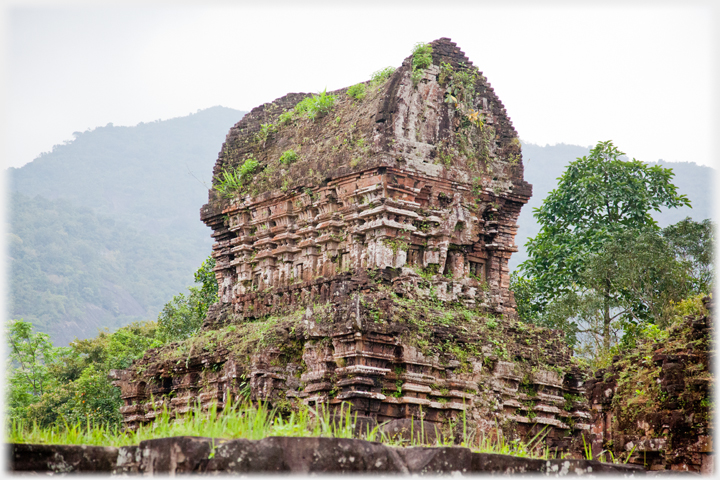 One of the 70 Hindu Temples at the Mỹ Sơn Site in central Vietnam
The
last page
One of the 70 Hindu Temples at the Mỹ Sơn Site in central Vietnam
The
last page
 showed some of the artefacts gathered into the museum at Da Nang, which were taken from the site at Mỹ Sơn (sounds a bit like 'Mihi Sern'), this page shows the site, or at least those bits of it which have survived the daily encroachment of the jungle, and the many wars, particularly the destruction caused by the American bombing of the area. Information was minimal at the time these pictures were taken in 2011, lamely too many captions just have to say 'Temple'.
showed some of the artefacts gathered into the museum at Da Nang, which were taken from the site at Mỹ Sơn (sounds a bit like 'Mihi Sern'), this page shows the site, or at least those bits of it which have survived the daily encroachment of the jungle, and the many wars, particularly the destruction caused by the American bombing of the area. Information was minimal at the time these pictures were taken in 2011, lamely too many captions just have to say 'Temple'.
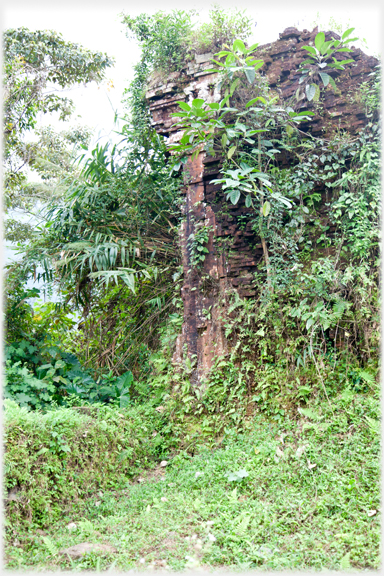 Jungle wins every battle hands down here in the heat and humidity of central Vietnam
Jungle wins every battle hands down here in the heat and humidity of central Vietnam
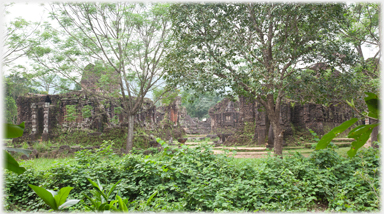 From some angles the temple complex appears extensive...
From some angles the temple complex appears extensive...
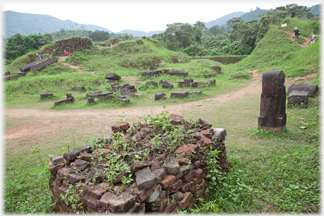 ...from others all that remains are the piles of rubble left by the bombing. Here one of the many lingam still stands
...from others all that remains are the piles of rubble left by the bombing. Here one of the many lingam still stands
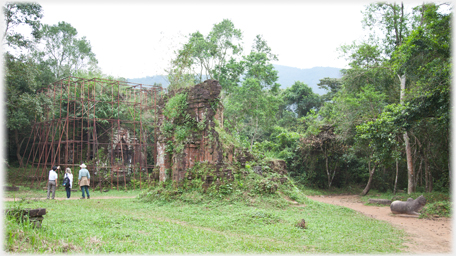 Some of the oldest buildings are partially supported and protected
Some of the oldest buildings are partially supported and protected
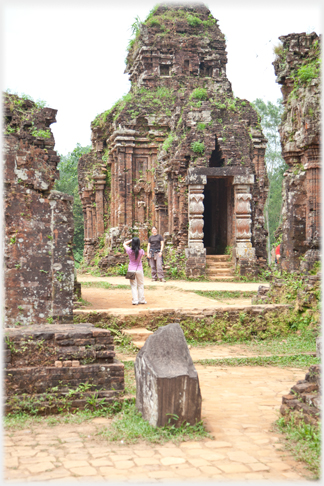 Mỹ Sơn was designated by UNESCO as a
World Heritage Site
Mỹ Sơn was designated by UNESCO as a
World Heritage Site
 in 1999
in 1999
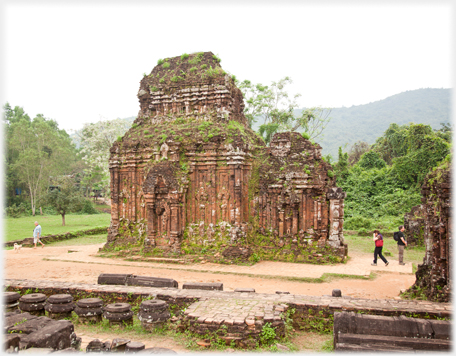 This whole temple complex seems to have been a religious and cultural centre for the Champas, separate from the political centre
This whole temple complex seems to have been a religious and cultural centre for the Champas, separate from the political centre
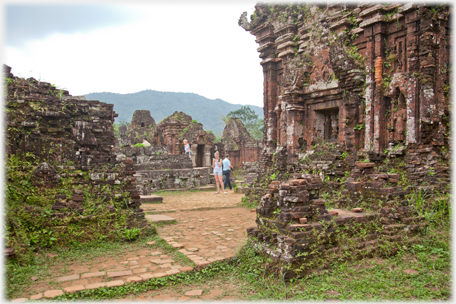 The temples grouped around the central area were mostly built in the ninth and tenth centuries at the height of the Champa regime
The temples grouped around the central area were mostly built in the ninth and tenth centuries at the height of the Champa regime
 Officially the whole site is the Mỹ Sơn Sanctuary, a phrase also used for this one building
Officially the whole site is the Mỹ Sơn Sanctuary, a phrase also used for this one building
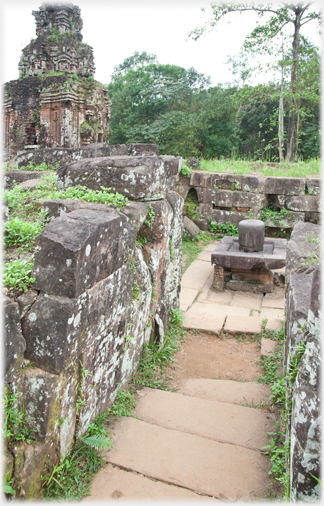 Passageway with one of the many lingams that dot the site
Passageway with one of the many lingams that dot the site
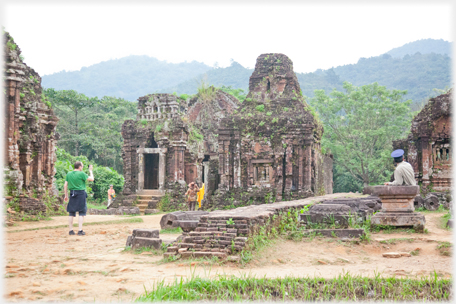 A guard watches over his monuments and the stream of photographers that try to capture them
A guard watches over his monuments and the stream of photographers that try to capture them
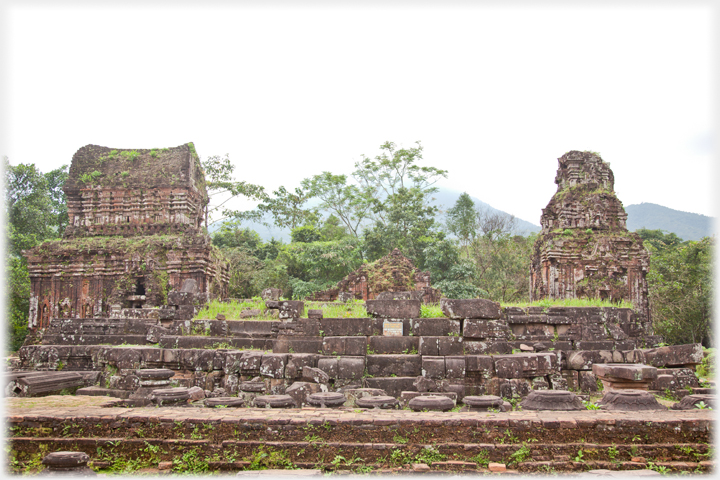 Temples near the entrance
Temples near the entrance
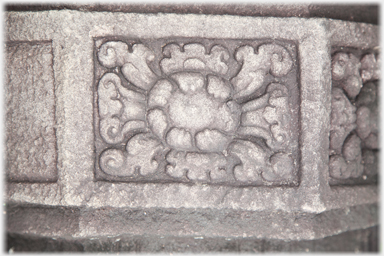 Floral carving on a column
Floral carving on a column
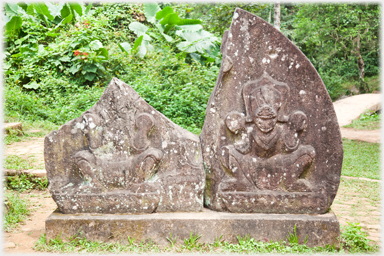 Two figure carvings with headdresses
Two figure carvings with headdresses
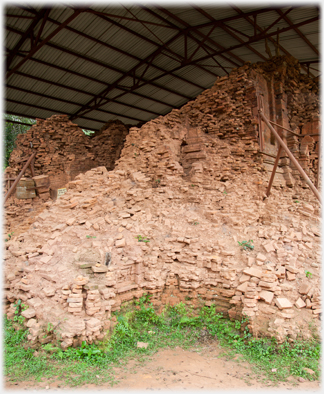
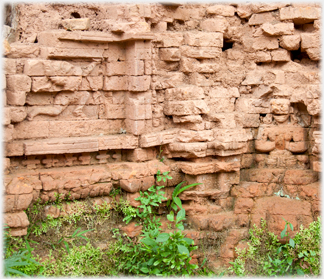 This corner of protected brickwork (left), has some of the oldest carvings, dating from the eighth century. In the picture above is a Buddha figure (right) and a dancing Hindu figure (left)
This corner of protected brickwork (left), has some of the oldest carvings, dating from the eighth century. In the picture above is a Buddha figure (right) and a dancing Hindu figure (left)
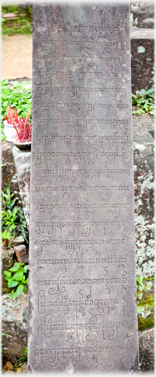 This strange script is written Cham, which is a descendent of the Indian Brahmi script. Brahmi was in use from about 2,300 years ago, notably for writing Sanskrit which was previously a purely oral language. Thus it was one of the first ways that speech, as opposed to the meaning of Chinese characters, was written down.
View an enlarged image in a new window.
This strange script is written Cham, which is a descendent of the Indian Brahmi script. Brahmi was in use from about 2,300 years ago, notably for writing Sanskrit which was previously a purely oral language. Thus it was one of the first ways that speech, as opposed to the meaning of Chinese characters, was written down.
View an enlarged image in a new window.
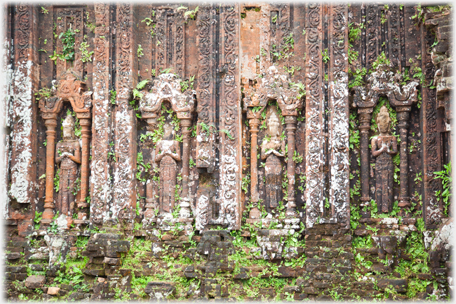 The remarkable thing about these carvings is that they are cut straight into the brick of the building. This process is still not fully understood, but it is likely that the building was constructed first of ready fired un-carved bricks, and that these were carved in situ
The remarkable thing about these carvings is that they are cut straight into the brick of the building. This process is still not fully understood, but it is likely that the building was constructed first of ready fired un-carved bricks, and that these were carved in situ
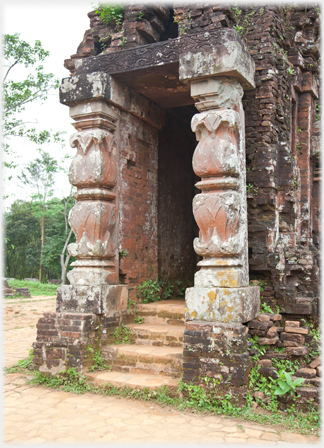 Intact entrance to a temple
Intact entrance to a temple
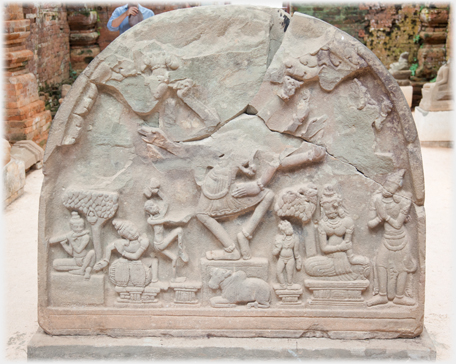 One temple has been cleaned and a number of carvings assembled in it, including this Hindu dancer
One temple has been cleaned and a number of carvings assembled in it, including this Hindu dancer
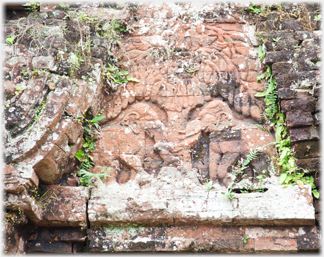 Carving of elephants
Carving of elephants
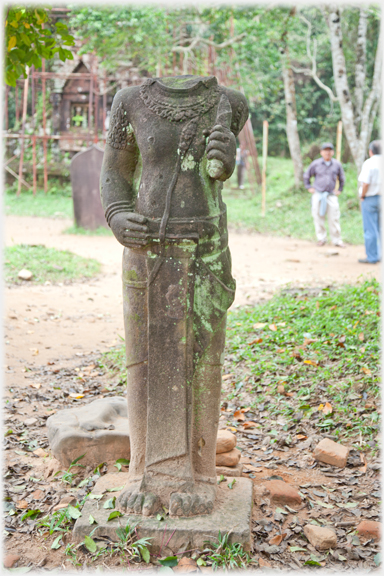 Statue of a regal figure
Statue of a regal figure
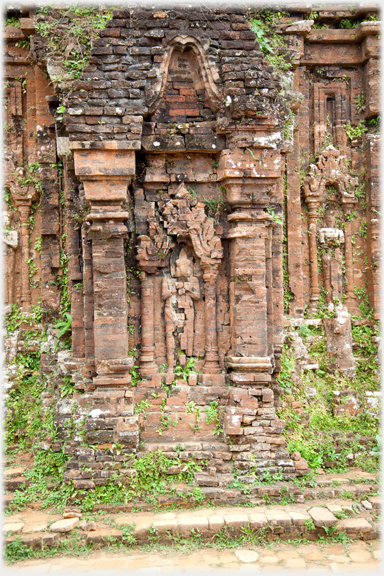 Figure in brick wall
Figure in brick wall
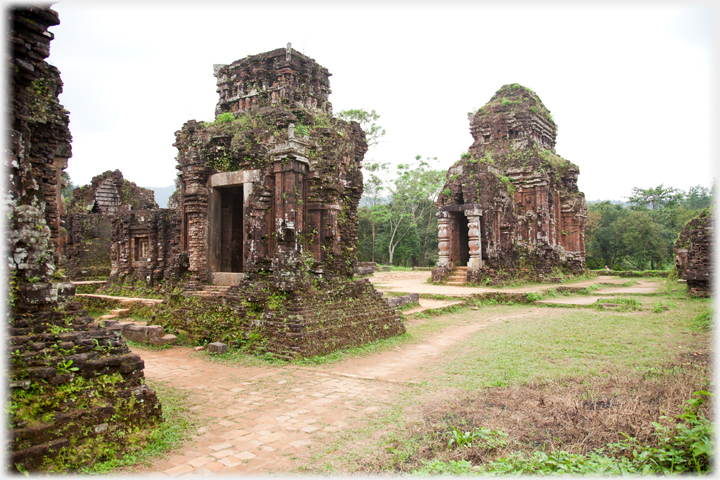 The whole site retains an equivocal air, the encroaching jungle, the piles of rubble from the bombing, the warnings that visitors should keep to paths; and these temples, dotted across the landscape, seeming tousled and unshaven, and a little unsure of their ancestry: Hindu, Buddhist, Confucian. Altogether a special place with that ever rarer quality of unpolished, unprocessed immediacy
The next page
takes you to something more on Hindu culture: a wedding in Delhi, along with a few shots of less commonly seen aspects of the town.
The whole site retains an equivocal air, the encroaching jungle, the piles of rubble from the bombing, the warnings that visitors should keep to paths; and these temples, dotted across the landscape, seeming tousled and unshaven, and a little unsure of their ancestry: Hindu, Buddhist, Confucian. Altogether a special place with that ever rarer quality of unpolished, unprocessed immediacy
The next page
takes you to something more on Hindu culture: a wedding in Delhi, along with a few shots of less commonly seen aspects of the town.
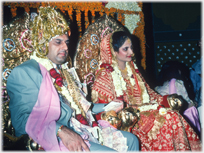

Saturday 8th April 2017

Go to the Picture Posting contents page
Return to the top
|
|
 One of the 70 Hindu Temples at the Mỹ Sơn Site in central Vietnam
The
last page
One of the 70 Hindu Temples at the Mỹ Sơn Site in central Vietnam
The
last page
 showed some of the artefacts gathered into the museum at Da Nang, which were taken from the site at Mỹ Sơn (sounds a bit like 'Mihi Sern'), this page shows the site, or at least those bits of it which have survived the daily encroachment of the jungle, and the many wars, particularly the destruction caused by the American bombing of the area. Information was minimal at the time these pictures were taken in 2011, lamely too many captions just have to say 'Temple'.
showed some of the artefacts gathered into the museum at Da Nang, which were taken from the site at Mỹ Sơn (sounds a bit like 'Mihi Sern'), this page shows the site, or at least those bits of it which have survived the daily encroachment of the jungle, and the many wars, particularly the destruction caused by the American bombing of the area. Information was minimal at the time these pictures were taken in 2011, lamely too many captions just have to say 'Temple'.
 Jungle wins every battle hands down here in the heat and humidity of central Vietnam
Jungle wins every battle hands down here in the heat and humidity of central Vietnam
 From some angles the temple complex appears extensive...
From some angles the temple complex appears extensive...
 ...from others all that remains are the piles of rubble left by the bombing. Here one of the many lingam still stands
...from others all that remains are the piles of rubble left by the bombing. Here one of the many lingam still stands
 Some of the oldest buildings are partially supported and protected
Some of the oldest buildings are partially supported and protected
 Mỹ Sơn was designated by UNESCO as a
World Heritage Site
Mỹ Sơn was designated by UNESCO as a
World Heritage Site
 in 1999
in 1999
 This whole temple complex seems to have been a religious and cultural centre for the Champas, separate from the political centre
This whole temple complex seems to have been a religious and cultural centre for the Champas, separate from the political centre
 The temples grouped around the central area were mostly built in the ninth and tenth centuries at the height of the Champa regime
The temples grouped around the central area were mostly built in the ninth and tenth centuries at the height of the Champa regime
 Officially the whole site is the Mỹ Sơn Sanctuary, a phrase also used for this one building
Officially the whole site is the Mỹ Sơn Sanctuary, a phrase also used for this one building
 Passageway with one of the many lingams that dot the site
Passageway with one of the many lingams that dot the site
 A guard watches over his monuments and the stream of photographers that try to capture them
A guard watches over his monuments and the stream of photographers that try to capture them
 Temples near the entrance
Temples near the entrance
 Floral carving on a column
Floral carving on a column
 Two figure carvings with headdresses
Two figure carvings with headdresses

 This corner of protected brickwork (left), has some of the oldest carvings, dating from the eighth century. In the picture above is a Buddha figure (right) and a dancing Hindu figure (left)
This corner of protected brickwork (left), has some of the oldest carvings, dating from the eighth century. In the picture above is a Buddha figure (right) and a dancing Hindu figure (left)
 This strange script is written Cham, which is a descendent of the Indian Brahmi script. Brahmi was in use from about 2,300 years ago, notably for writing Sanskrit which was previously a purely oral language. Thus it was one of the first ways that speech, as opposed to the meaning of Chinese characters, was written down.
View an enlarged image in a new window.
This strange script is written Cham, which is a descendent of the Indian Brahmi script. Brahmi was in use from about 2,300 years ago, notably for writing Sanskrit which was previously a purely oral language. Thus it was one of the first ways that speech, as opposed to the meaning of Chinese characters, was written down.
View an enlarged image in a new window.
 The remarkable thing about these carvings is that they are cut straight into the brick of the building. This process is still not fully understood, but it is likely that the building was constructed first of ready fired un-carved bricks, and that these were carved in situ
The remarkable thing about these carvings is that they are cut straight into the brick of the building. This process is still not fully understood, but it is likely that the building was constructed first of ready fired un-carved bricks, and that these were carved in situ
 Intact entrance to a temple
Intact entrance to a temple
 One temple has been cleaned and a number of carvings assembled in it, including this Hindu dancer
One temple has been cleaned and a number of carvings assembled in it, including this Hindu dancer
 Carving of elephants
Carving of elephants
 Statue of a regal figure
Statue of a regal figure
 Figure in brick wall
Figure in brick wall
 The whole site retains an equivocal air, the encroaching jungle, the piles of rubble from the bombing, the warnings that visitors should keep to paths; and these temples, dotted across the landscape, seeming tousled and unshaven, and a little unsure of their ancestry: Hindu, Buddhist, Confucian. Altogether a special place with that ever rarer quality of unpolished, unprocessed immediacy
The next page
takes you to something more on Hindu culture: a wedding in Delhi, along with a few shots of less commonly seen aspects of the town.
The whole site retains an equivocal air, the encroaching jungle, the piles of rubble from the bombing, the warnings that visitors should keep to paths; and these temples, dotted across the landscape, seeming tousled and unshaven, and a little unsure of their ancestry: Hindu, Buddhist, Confucian. Altogether a special place with that ever rarer quality of unpolished, unprocessed immediacy
The next page
takes you to something more on Hindu culture: a wedding in Delhi, along with a few shots of less commonly seen aspects of the town.


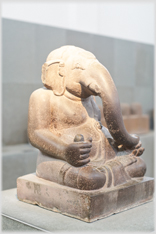
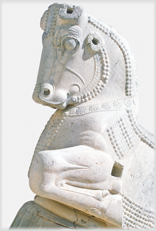
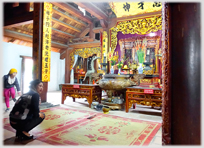 To a modern Vietnamese Temple - Đền Cờn
To a modern Vietnamese Temple - Đền Cờn
